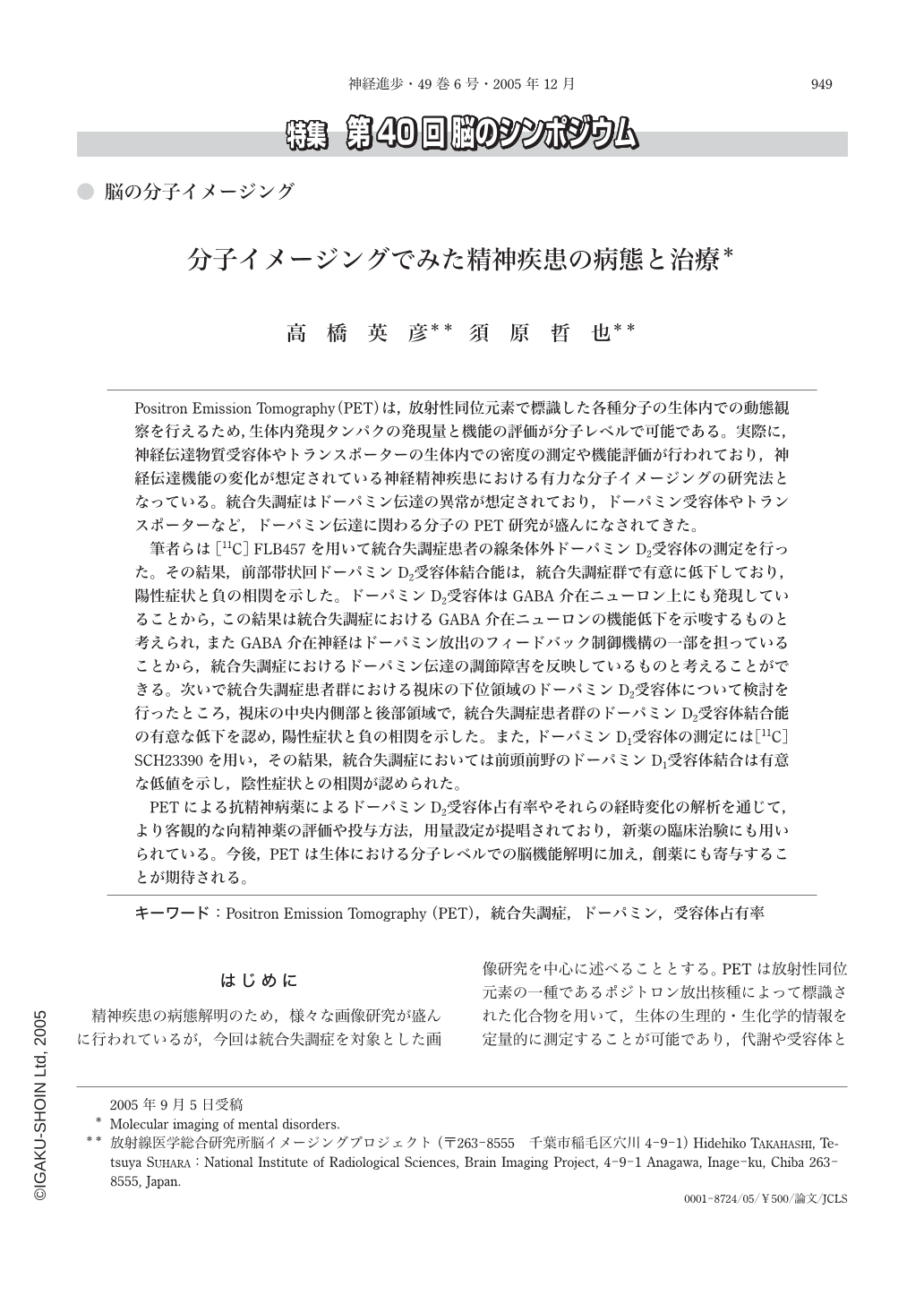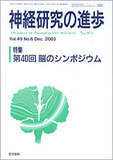Japanese
English
- 有料閲覧
- Abstract 文献概要
- 1ページ目 Look Inside
Positron Emission Tomography(PET)は,放射性同位元素で標識した各種分子の生体内での動態観察を行えるため,生体内発現タンパクの発現量と機能の評価が分子レベルで可能である。実際に,神経伝達物質受容体やトランスポーターの生体内での密度の測定や機能評価が行われており,神経伝達機能の変化が想定されている神経精神疾患における有力な分子イメージングの研究法となっている。統合失調症はドーパミン伝達の異常が想定されており,ドーパミン受容体やトランスポーターなど,ドーパミン伝達に関わる分子のPET研究が盛んになされてきた。
筆者らは[11C]FLB457を用いて統合失調症患者の線条体外ドーパミンD2受容体の測定を行った。その結果,前部帯状回ドーパミンD2受容体結合能は,統合失調症群で有意に低下しており,陽性症状と負の相関を示した。ドーパミンD2受容体はGABA介在ニューロン上にも発現していることから,この結果は統合失調症におけるGABA介在ニューロンの機能低下を示唆するものと考えられ,またGABA介在神経はドーパミン放出のフィードバック制御機構の一部を担っていることから,統合失調症におけるドーパミン伝達の調節障害を反映しているものと考えることができる。次いで統合失調症患者群における視床の下位領域のドーパミンD2受容体について検討を行ったところ,視床の中央内側部と後部領域で,統合失調症患者群のドーパミンD2受容体結合能の有意な低下を認め,陽性症状と負の相関を示した。また,ドーパミンD1受容体の測定には[11C]SCH23390を用い,その結果,統合失調症においては前頭前野のドーパミンD1受容体結合は有意な低値を示し,陰性症状との相関が認められた。
PETによる抗精神病薬によるドーパミンD2受容体占有率やそれらの経時変化の解析を通じて,より客観的な向精神薬の評価や投与方法,用量設定が提唱されており,新薬の臨床治験にも用いられている。今後,PETは生体における分子レベルでの脳機能解明に加え,創薬にも寄与することが期待される。
Positron emission tomography(PET)techniques have made it possible to measure changes in neurochemical components in living human brain. PET can be used to investigate various brain functions such as receptors, transporters, enzymes and various biochemical pathways;therefore, it could be a powerful tool for molecular imaging of mental disorders.
Since the pathophysiology of schizophrenia has been discussed with a functional alteration of dopaminergic transmission in the brain, we have focused the dopaminergic components for the research target of schizophrenia using PET. Using high affinity ligand [11C]FLB 457, we found reduced D2 receptor binding in the anterior cingulate cortex of patients with schizophrenia, and a significant negative correlation was observed between D2 receptor binding and the positive symptom score. Subregions of interest were defined on the thalamus using individual magnetic resonance images. D2 receptor binding was also lower in the central medial and posterior subregions of the thalamus in patients with schizophrenia. Alterations in D2 receptor function in the extrastriatal region may underlie the positive symptoms of schizophrenia. On the other hand D1 receptor binding was found to be lower in the prefrontal cortex and a significant negative correlation was observed between D1 receptor binding and the negative symptom score. Abnormality of D1 receptor function would be at the bottom of the negative symptoms and cognitive impairment of schizophrenia.
Regarding the effect of antipsychotics on dopamine D2 receptor, occupancy and it's time-course have been measured in a living body using PET. This approach can provide in vivo pharmacological evidences of antipsychotics and establish the rational therapeutic strategy. PET is a powerful tool not only in the field of brain research but also drug discovery.

Copyright © 2005, Igaku-Shoin Ltd. All rights reserved.


